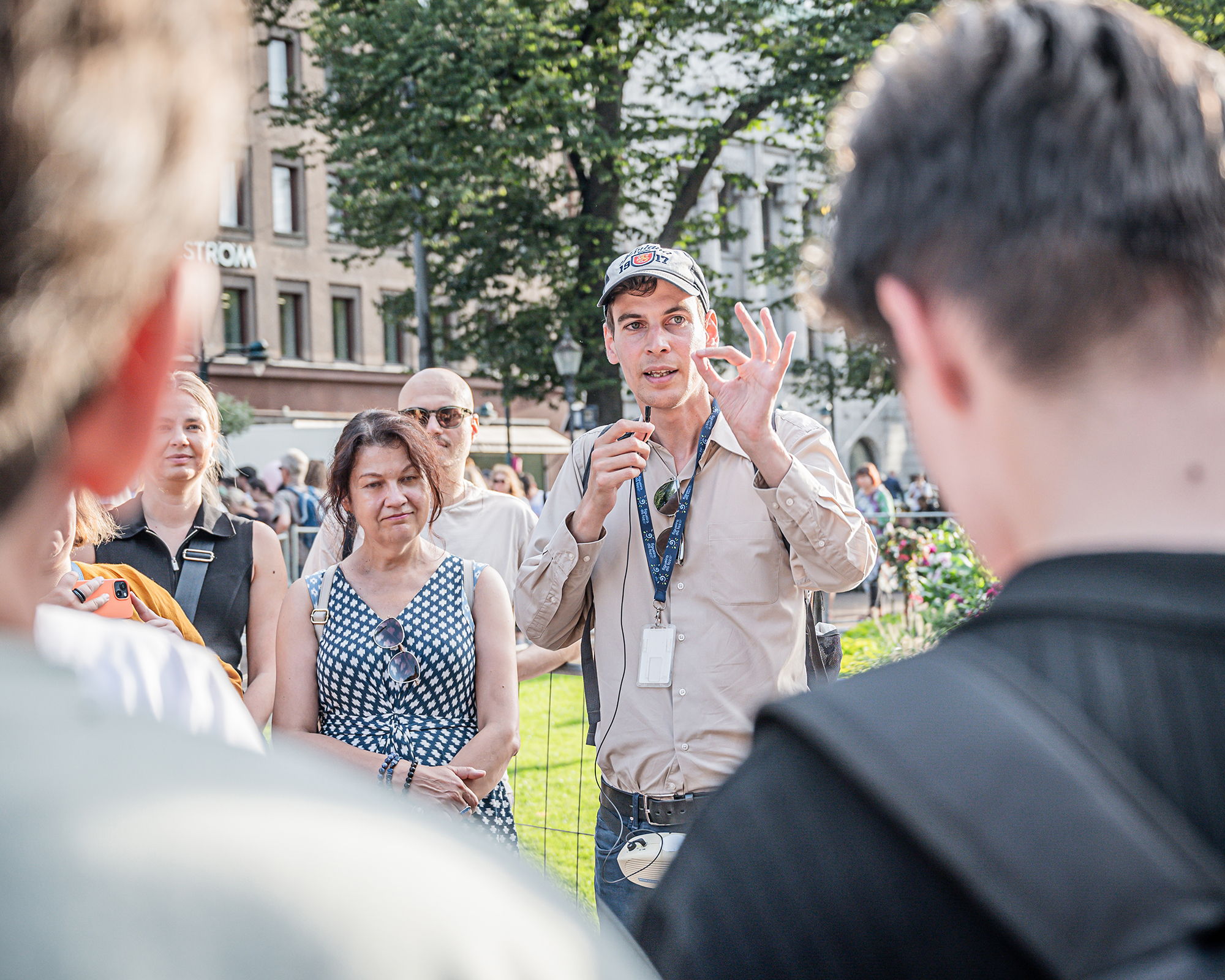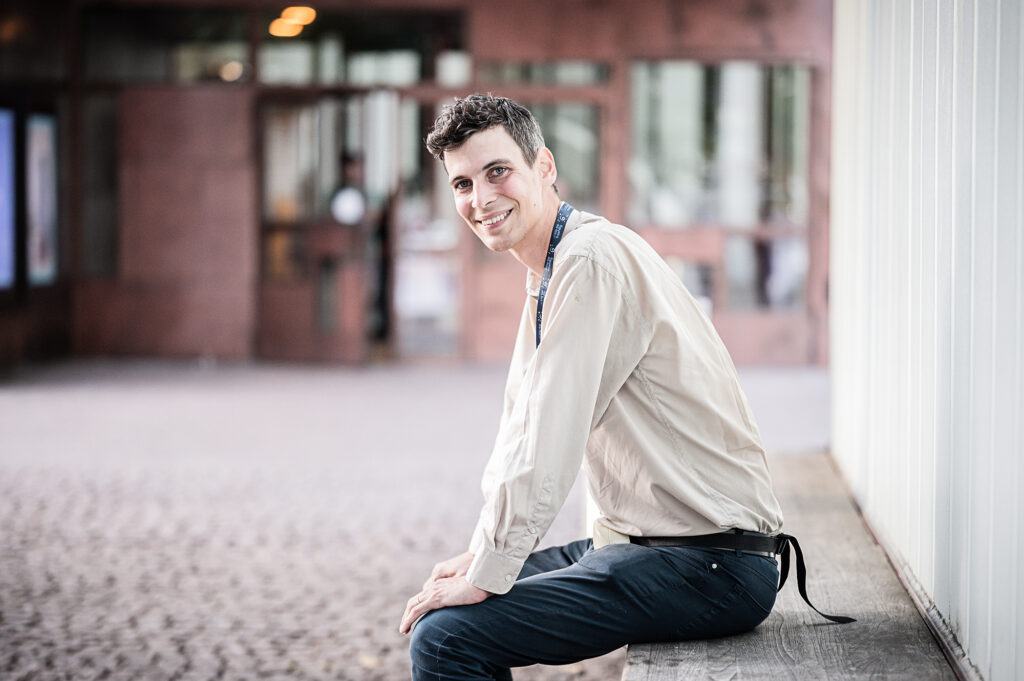Fifty people experienced Helsinki in Interslavic – a language a Slavic speaker understands without studying

Anyone who speaks any Slavic language was welcome to join the Interslavic tour.
Oksana Chelysheva
Sercan Alkan
Published 27.08.2024 at 3:20
Updated 29.08.2024 at 2:32
On August 15th the Senate Square in Helsinki was crammed with people. The mood was joyful thanks to the friendly atmosphere of the Night of the Arts.
There was a group of up to fifty people eager to get the experience of the first-ever Helsinki tour in the Interslavic language. The Night of the Arts had invited ”people speaking Bulgarian, Bosnian, Czech, Church Slavic, Croatian, Polish, Russian, Slovak, Slovenian, Serbian, or Ukrainian” to join.
The Interslavic is artificial language that can be understood by speakers of all Slavic languages. It’s the newest of the existing languages officially registered in April 2024.
The tour was organized by Emil Anton, Doctor of Theology from the university of Helsinki, and an authorised tourist guide in Helsinki.
Anton has learned multiple Slavic languages, Polish being the first. His first interaction with Interslavic came only a little more than a year ago.
He learned about the language from a YouTube channel. Anton was stunned, as he realized that he was immediately able to understand it.
During following year, Anton went through textbooks, listened to songs and interacted with other enthusiasts. Now his knowledge of Interslavic is so good that he was able to organize a tour.
The tour started from the monument to Emperor Alexander II in Senate square and ended by the statue of Marshal Mannerheim in front of the Kiasma Museum.
In between, Anton took people through the sites that mark interaction between Finnish and Slavic cultures, be it the Slavonic library, an Orthodox church or the Vltava restaurant.
Sirpa Nietoksela was one of the few Finnish participants. She had no previous knowledge of the Interslavic language.
Nietoksela has studied many Slavic languages at the University of Zagreb, Croatia, later working with mostly Croatian and Russian. She felt that the tour proved that Interslavic works well among both non-Slavic and Slavic people.
“My knowledge of Slavic languages helps me a lot to communicate to people in other Slavic countries but for those who do not speak many languages, such an auxiliary tool can be of great help.”
That was proved at the end of the tour, when Anton asked the participants, how much they understood. About 80 percent of the group told with confidence that they had understood from 90 to 100 percent, regardless of their native language.
Years of work by multiple language experts
Dutch professional translator Jan van Steenbergen is one of the creators of Interslavic. He remembers that as he started working with the project in 2006, he did not have great expectations.
“I decided to give it a try, mostly because I was curious if such a thing would be possible at all.”
There had been individual attempts to create a common Slavic language already in the 20th century, namely by Czech, Sloven and Croatian authors, but those had not produced meaningful results.
During the first decade of 2000s, the work was initially done in three different groups experimenting with different grammar models. In 2011, the projects merged.
After years of linguistic analysis, computer modelling and personal interaction, grammar for new artificial language was unified in 2017.
“The funny thing about Interslavic is that you don’t need to learn it the way people normally learn a foreign language”, van Steenbergen says.
“Instead, you learn how to transform a Slavic language you already know.”
Interslavic has its own grammar and vocabulary, but it is understandable if you know any Slavic language. That’s possible, because Interslavic is based on all living Slavic languages giving them equal weight, Van Steenbergen explains.
There never was an intention to build a community of Interslavic speakers
Van Steenbergen compares Interslavic to the most famous artificial language, Esperanto, which was created in 1880’s in Poland.
If one want’s to understand Esperanto, one has to learn it from the scratch. The idea of Interslavic is different.
“Esperanto can only be used for communication with other Esperantists. Outside of of Esperanto speakers, there is no use for it,” van Steenbergen says.
“Interslavic is kind of the opposite: it was never meant to become the language of a community of Interslavic speakers. It serves as a tool to communicate with Slavic speakers who probably won’t even know what Interslavic is but can understand it anyway.”
The success of Interslavic has exceeded van Steenbergens expectations.
The Interslavic Facebook group has more than 21 000 subscribers. Several dictionaries have been compiled.
Aleksy Bernat from Poland has published albums of music and the first book written in Interslavic Nehaj nesut nas běle oblaky (“Let The White Clouds Carry Us”). Jan van Steenbergen has translated The Little Prince by Antoine de Saint-Exupéry into it.
Van Steenberg alongside Steven Radzikovski from the USA and Vojtech Merunka from Czechia were awarded the honorary medal of the Czech linguist Josef Dobrovsky “in the name of Slavic unity” for developing this auxiliary Slavic language.
Future uses in education and in tourism
According to Jan van Steenberg, Interslavic has uses for instance in education.
“During our Interslavic conferences, we had an interpreter who translated all presentations to Interslavic. That was served the entire audience from 12 countries”.

Emil Anton sees a great potential for Interslavic in tourism. He also feels that Interslavic is more attractive for communication among Slavs than English.
He has own experience with a group of honorary consuls of different European countries.
“I started the excursion in English. Then I saw that they were not listening and switched to Interslavic”.
The group looked bewildered but got curious.
“I asked those who understood me to show it by clapping hands. Almost all of them did”.
Also the first Interslavic tour of Helsinki was a success. The organizers of the Night of the Arts sent Emil Anton a message expressing their joy at the number of people who showed up.
A video from the tour was posted on Interslavic language’s YouTube channel. It has collected over 2500 views and more that 50 comments.